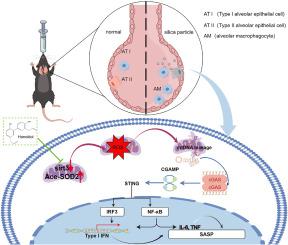当前位置:
X-MOL 学术
›
Redox Biol.
›
论文详情
Our official English website, www.x-mol.net, welcomes your feedback! (Note: you will need to create a separate account there.)
Activation of Sirtuin3 by honokiol ameliorates alveolar epithelial cell senescence in experimental silicosis via the cGAS-STING pathway
Redox Biology ( IF 10.7 ) Pub Date : 2024-06-08 , DOI: 10.1016/j.redox.2024.103224 Qiang Zhou 1 , Guan Yi 2 , Meiyu Chang 2 , Ning Li 2 , Yichun Bai 3 , Haibin Li 1 , Sanqiao Yao 1
Redox Biology ( IF 10.7 ) Pub Date : 2024-06-08 , DOI: 10.1016/j.redox.2024.103224 Qiang Zhou 1 , Guan Yi 2 , Meiyu Chang 2 , Ning Li 2 , Yichun Bai 3 , Haibin Li 1 , Sanqiao Yao 1
Affiliation

|
Silicosis, characterized by interstitial lung inflammation and fibrosis, poses a significant health threat. ATII cells play a crucial role in alveolar epithelial repair and structural integrity maintenance. Inhibiting ATII cell senescence has shown promise in silicosis treatment. The study employed male C57BL/6 N mice and A549 human alveolar epithelial cells to investigate silicosis and its potential treatment. Silicosis was induced in mice via intratracheal instillation of crystalline silica particles, with honokiol administered intraperitoneally for 14 days. Silica-induced senescence in A549 cells was confirmed, and SIRT3 knockout and overexpression cell lines were generated. Various analyses were conducted, including immunoblotting, qRT-PCR, histology, and transmission electron microscopy. Statistical significance was determined using one-way ANOVA with Tukey's post-hoc test. This study elucidates how silica induces ATII cell senescence, emphasizing mtDNA damage. Notably, honokiol (HKL) emerges as a promising anti-senescence and anti-fibrosis agent, acting through sirt3. honokiol effectively attenuated senescence in ATII cells, dependent on sirt3 expression, while mitigating mtDNA damage. Sirt3, a class III histone deacetylase, regulates senescence and mitochondrial stress. HKL activates sirt3, protecting against pulmonary fibrosis and mitochondrial damage. Additionally, HKL downregulated cGAS expression in senescent ATII cells induced by silica, suggesting sirt3's role as an upstream regulator of the cGAS/STING signaling pathway. Moreover, honokiol treatment inhibited the activation of the NF-κB signaling pathway, associated with reduced oxidative stress and mtDNA damage. Notably, HKL enhanced the activity of SOD2, crucial for mitochondrial function, through sirt3-mediated deacetylation. Additionally, HKL promoted the deacetylation activity of sirt3, further safeguarding mtDNA integrity. This study uncovers a natural compound, HKL, with significant anti-fibrotic properties through activating sirt3, shedding light on silicosis pathogenesis and treatment avenues.
中文翻译:

和厚朴酚激活 Sirtuin3 通过 cGAS-STING 途径改善实验性矽肺患者肺泡上皮细胞衰老
矽肺以间质性肺炎症和纤维化为特征,对健康构成重大威胁。 ATII 细胞在肺泡上皮修复和结构完整性维护中发挥着至关重要的作用。抑制 ATII 细胞衰老在矽肺治疗中显示出前景。该研究采用雄性 C57BL/6 N 小鼠和 A549 人肺泡上皮细胞来研究矽肺及其潜在治疗方法。通过气管内滴注结晶二氧化硅颗粒并腹膜内施用和厚朴酚 14 天,诱发小鼠矽肺。证实了二氧化硅诱导 A549 细胞衰老,并产生了 SIRT3 敲除和过表达细胞系。进行了各种分析,包括免疫印迹、qRT-PCR、组织学和透射电子显微镜。使用单向方差分析和 Tukey 事后检验确定统计显着性。这项研究阐明了二氧化硅如何诱导 ATII 细胞衰老,强调 mtDNA 损伤。值得注意的是,和厚朴酚 (HKL) 通过 Sirt3 发挥作用,成为一种有前途的抗衰老和抗纤维化药物。和厚朴酚可有效减弱 ATII 细胞的衰老(依赖于 Sirt3 的表达),同时减轻 mtDNA 损伤。 Sirt3 是一种 III 类组蛋白脱乙酰酶,可调节衰老和线粒体应激。 HKL 激活 Sirt3,防止肺纤维化和线粒体损伤。此外,HKL 下调了二氧化硅诱导的衰老 ATII 细胞中的 cGAS 表达,表明 Sirt3 作为 cGAS/STING 信号通路上游调节因子的作用。此外,和厚朴酚治疗可抑制 NF-κB 信号通路的激活,从而减少氧化应激和 mtDNA 损伤。 值得注意的是,HKL 通过 Sirt3 介导的脱乙酰化增强了对线粒体功能至关重要的 SOD2 活性。此外,HKL还促进sirt3的脱乙酰化活性,进一步保护mtDNA的完整性。这项研究发现了一种天然化合物 HKL,通过激活 Sirt3 具有显着的抗纤维化特性,为矽肺发病机制和治疗途径提供了线索。
更新日期:2024-06-08
中文翻译:

和厚朴酚激活 Sirtuin3 通过 cGAS-STING 途径改善实验性矽肺患者肺泡上皮细胞衰老
矽肺以间质性肺炎症和纤维化为特征,对健康构成重大威胁。 ATII 细胞在肺泡上皮修复和结构完整性维护中发挥着至关重要的作用。抑制 ATII 细胞衰老在矽肺治疗中显示出前景。该研究采用雄性 C57BL/6 N 小鼠和 A549 人肺泡上皮细胞来研究矽肺及其潜在治疗方法。通过气管内滴注结晶二氧化硅颗粒并腹膜内施用和厚朴酚 14 天,诱发小鼠矽肺。证实了二氧化硅诱导 A549 细胞衰老,并产生了 SIRT3 敲除和过表达细胞系。进行了各种分析,包括免疫印迹、qRT-PCR、组织学和透射电子显微镜。使用单向方差分析和 Tukey 事后检验确定统计显着性。这项研究阐明了二氧化硅如何诱导 ATII 细胞衰老,强调 mtDNA 损伤。值得注意的是,和厚朴酚 (HKL) 通过 Sirt3 发挥作用,成为一种有前途的抗衰老和抗纤维化药物。和厚朴酚可有效减弱 ATII 细胞的衰老(依赖于 Sirt3 的表达),同时减轻 mtDNA 损伤。 Sirt3 是一种 III 类组蛋白脱乙酰酶,可调节衰老和线粒体应激。 HKL 激活 Sirt3,防止肺纤维化和线粒体损伤。此外,HKL 下调了二氧化硅诱导的衰老 ATII 细胞中的 cGAS 表达,表明 Sirt3 作为 cGAS/STING 信号通路上游调节因子的作用。此外,和厚朴酚治疗可抑制 NF-κB 信号通路的激活,从而减少氧化应激和 mtDNA 损伤。 值得注意的是,HKL 通过 Sirt3 介导的脱乙酰化增强了对线粒体功能至关重要的 SOD2 活性。此外,HKL还促进sirt3的脱乙酰化活性,进一步保护mtDNA的完整性。这项研究发现了一种天然化合物 HKL,通过激活 Sirt3 具有显着的抗纤维化特性,为矽肺发病机制和治疗途径提供了线索。
















































 京公网安备 11010802027423号
京公网安备 11010802027423号